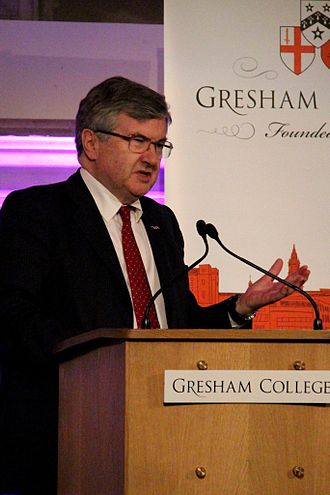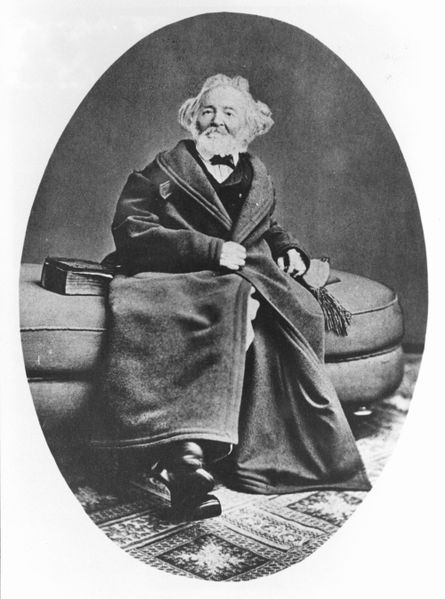
Postmodernism has been making its inroads into historical Jesus studies with what I think are most convenient results. This post is a plug for the old-fashioned rules for the proper way to do history. We can’t get any more old-fashioned than the nineteenth century founder of modern history, Leopold von Ranke, who has become a byword in many circles for doing history badly. It’s been a long time since I’ve discussed his contribution to historical studies and their relevance to biblical studies in particular so let’s do another post now. Previously I deferred to the Old Testament biblical scholar Niels Peter Lemche’s for the positives that Ranke still necessarily offers the modern historian. This time I’m inviting the modern historian (a specialist on Hitler’s Germany), Richard J. Evans, to take the floor.
We’re a bit late for the start of his talk because he’s already into the third significant contribution Ranke made for the modern study of history.
Thirdly, and perhaps most importantly, Ranke introduced into the study of modern history the methods that had recently been developed by philologists in the study of ancient and medieval literature to determine whether a text, say of a Shakespeare play or of a medieval legend like the Nibelungenlied, was true or corrupted by later interpolations, whether it was written by the author it was supposed to be written by, and which of the available versions was the most reliable. Historians, argued Ranke, had to root out forgeries and falsifications from the record. They had to test documents on the basis of their internal consistency, and their consistency with other documents originating at the same period. They had to stick to ‘primary sources’, eyewitness reports and what Ranke called the ‘purest, most immediate documents’ which could be shown to have originated at the time under investigation, and avoid reliance on ‘secondary sources’ such as memoirs or histories generated after the event. Moreover, they had to investigate and subject to the critical method all the sources relating to the events in which they were interested. They should not be content, as for example Gibbon had been, to rely on printed documents and chronicles generally available in libraries. They had instead to sally forth, as Ranke did, into the archives, to work their way through the vast unpublished hoards of original manuscripts stored up by the state chancelleries of Europe. Only then, by gathering, criticizing and verifying all the available sources, could they put themselves in a position to reconstruct the past accurately.
The application of philological techniques to historical sources was a major breakthrough. Ranke’s principles still form the basis for much historical research and teaching today. History Special Subjects in many British universities, for example, offer a basic training in source-criticism; students are examined on extracts or ‘gobbets’ from set documents and are expected to comment on them in terms of their internal consistency, their relationship to other documents on the same subject, their reliability and their usefulness as a source. Questions of authenticity and attribution continue to be vitally important in historical research. Forgeries, as the lamentable case of the ‘Hitler Diaries’ showed over a decade ago, are still regrettably common; outright falsification and doctoring of the evidence abound in printed collections of documents and other publications relating to subjects such as the origins of the First World War and the Third Reich. They are even more common in medieval history.
And we know, don’t we, just how prevalent forgeries were in the ancient world, too, right?
Technological innovation has added substantially to the Rankean armoury; the ‘Hitler Diaries’ were easily exposed as forgeries by simple testing of the age of the paper on which they were written, which dated from the 1950s; perhaps Hugh Trevor-Roper (Lord Dacre), who originally ‘authenticated’ them for the London Times newspaper, should not have rested content with the fact that the name ‘Adolf Hitler’ was signed at the bottom of every page.7 Whatever the means they use, historians still have to engage in the basic Rankean spadework of investigating the provenance of documents, of enquiring about the motives of those who wrote them, the circumstances in which they were written, and the ways in which they relate to other documents on the same subject. The perils which await them should they fail to do this are only too obvious.
Here is where I find the pain most acute. It almost seems to be an obligatory rule for any scholar of Christian origins to begin with the presumption that the canonical gospels originated with good honest men and true who wanted nothing more than to save souls administering appropriate layers of theological insight and metaphor to the genuinely biographical reports orally circulating about Jesus. Literary analysis, the “testing of the documents on the basis of . . . their consistency with other documents originating [or well known and used] at the same period”, is set aside as an irrelevance, a quaint literary interest. Real history, we are too often told, requires us to imagine untestable oral traditions that were the real foundation of stories that otherwise have such evident tell-tale signs of being adapted from other literature.
All these things have belonged to the basic training of historians since the nineteenth century, and rightly so. However many forgeries and falsifications there have been, they seldom escape undetected for long. Sceptics who point to the fact that all sources are ‘biased’, and conclude from this that historians are bound to be misled by them, are as wide of the mark as politicians who imagine that future historians will take their memoirs on trust. Nor is there anything unusual in the fact that a modern discipline places such heavy reliance on principles developed over a century and a half before: chemistry, for example, still uses the periodic table of elements, while medical research continues to employ the mid-nineteenth-century device of ‘Koch’s postulates’ to prove that a micro-organism is the carrier of a particular disease. These analogies with scientific method point up the fact that when source-criticism was introduced into historical study, it too was regarded as a ‘scientific’ technique. Its use legitimated history as an independent profession, and those historians in other countries who wanted to establish themselves on a professional basis soon began to flock to Germany to undergo training at the feet of its leading exponents in Göttingen and Berlin.
Evans, Richard J.. In Defence Of History (Kindle Locations 435-471). Granta Books. Kindle Edition.

If you enjoyed this post, please consider donating to Vridar. Thanks!

“Real history, we are too often told, requires us to imagine untestable oral traditions that were the real foundation of stories”
You know, that’s the same reason believers in alien spaceships, bigfoot, crop circles, etc use.
Unlike counterfeit money or paintings, rarely is any forger sufficiently educated to be completely familiar with the historical context. Forgeries of writings are always perpetuated by people who have an agenda. The same thing happens with fake news today. People retweet things because they want them to be true not because they checked the source. Future historians will have a hard time dealing with all the “fake news” talk.